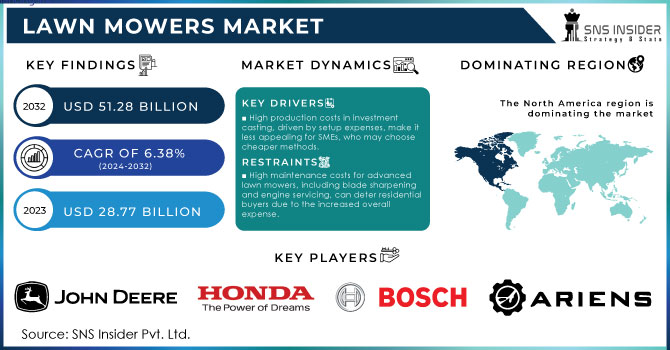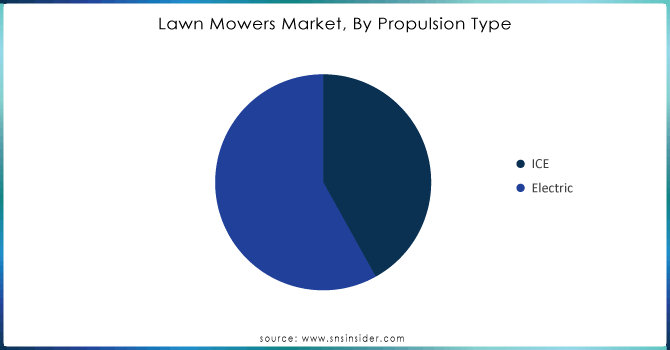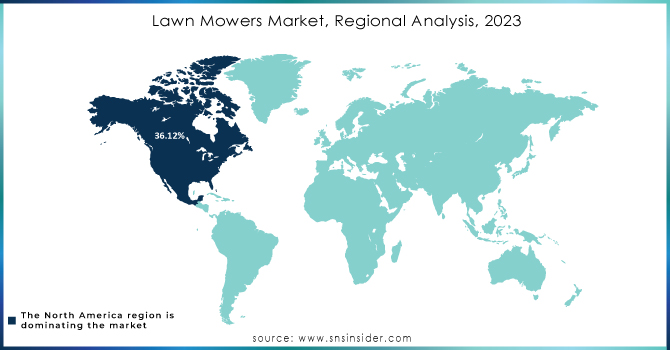Lawn Mowers Market Report Scope & Overview:
The Lawn Mowers Market Size was esteemed at USD 28.77 billion in 2023 and is supposed to arrive at USD 51.28 billion by 2032 and develop at a CAGR of 6.38% over the forecast period 2024-2032.

To Get More Information on Lawn Mowers Market - Request Sample Report
The lawn mower market has seen substantial growth in recent years, fueled by increasing demand for both residential and commercial landscaping. This surge is largely attributed to a rising trend in maintaining aesthetically pleasing outdoor spaces and a growing interest in gardening and lawn mowers. Technological innovations, including robotic and electric mowers, have significantly contributed to this market expansion. Additionally, there is a noticeable shift towards environmentally friendly and energy-efficient products as consumers become more conscious of their carbon footprint, leading to a preference for electric and battery-operated mowers. Manufacturers are actively investing in research and development to create more sustainable options, further driving market growth.
Key factors influencing this trend include advancements in technology, such as smart features like Bluetooth connectivity and automated navigation, which enhance user experience and increase the popularity of robotic lawn mowers for their convenience and efficiency. Urbanization is also playing a crucial role, as expanding urban areas boost the demand for landscaping and lawn mowers, supported by urban gardening initiatives that encourage homeowners to invest in maintenance equipment. The pandemic has further sparked interest in gardening as a leisure activity, resulting in higher sales of lawn mowers as consumers seek tools for lawn mowers.
Furthermore, the rise of smart technology in lawn mowers has led to features like Bluetooth connectivity and automated navigation, making robotic mowers increasingly popular. Reports indicate that approximately 20% of new lawn mower sales are now electric models, showcasing a shift in consumer preferences toward more sustainable options. The interest in gardening as a leisure activity, particularly during the pandemic, has also led to a 30% increase in lawn mower sales, as homeowners invest in maintaining their outdoor spaces. This trend is further supported by a growing commitment from manufacturers to develop energy-efficient and eco-friendly products, aligning with consumers' heightened awareness of their carbon footprints.
MARKET DYNAMICS
DRIVERS
- The rising interest in landscaping and gardening as popular hobbies, especially in urban and suburban areas, is driving the lawn mowers market as homeowners increasingly invest in lawn mowers products to enhance their outdoor aesthetics.
The increasing demand for lawn mowers, especially in urban and suburban regions, is a significant growth driver for the lawn mowers market. Landscaping and gardening have become popular hobbies, as homeowners are now more focused on maintaining well-kept, aesthetically pleasing outdoor spaces. This trend is driven by a desire for improved home environments, increased property value, and better outdoor living spaces. Lawns, gardens, and landscaped areas have become integral parts of modern homes, particularly in suburban settings where residents have more land to maintain.
In the United States alone, about 75% of households have some form of lawn, totaling around 40 million acres of grass. As people spend more time at home, especially with trends like remote work and an increased focus on health and wellness, they are investing in their outdoor spaces. Lawn mowers is a key aspect of these improvements, requiring regular upkeep through mowing, trimming, and edging. This has led to a rise in the sales of lawn mowers, from basic manual models to more advanced electric or robotic options that offer convenience and efficiency.
Moreover, social media and lifestyle trends showcasing beautiful lawns and gardens have further fueled the popularity of outdoor aesthetics. Research indicates that homeowners are more likely to invest in high-quality lawn mowers products, including lawn mowers, to achieve these visual goals. With an estimated 40% of U.S. homeowners considering outdoor landscaping projects, this growing demand for lawn maintenance tools and equipment is a key factor in the expanding lawn mowers market. As urban and suburban landscaping continues to gain popularity, the market for lawn mowers is expected to expand further.
- Technological advancements, including robotic and cordless electric mowers with smart connectivity, have significantly improved convenience and efficiency in lawn mowers, driving consumer preference for advanced models and fueling market growth.
Technological advancements in lawn mowers have significantly transformed the landscape of lawn mowers, leading to increased consumer adoption of advanced models. Innovations such as robotic lawn mowers, cordless electric mowers, and smart connectivity features have enhanced convenience and efficiency in lawn maintenance. Robotic mowers, for instance, can autonomously navigate lawns, utilizing sensors and GPS technology to optimize their mowing patterns. Cordless electric mowers, which eliminate the hassle of tangled cords and the emissions associated with gas-powered mowers, have gained popularity among environmentally conscious consumers. These mowers offer quieter operation, making them suitable for residential areas. A notable trend is the increasing emphasis on smart connectivity, with many modern mowers featuring smartphone apps that allow users to schedule mowing sessions and monitor mower performance from their devices.
Additionally, advancements in battery technology have improved the runtime and efficiency of electric models, making them more appealing to a broader audience. As consumers prioritize ease of use and sustainability, they are more inclined to invest in these innovative products, boosting market growth. This technological evolution in lawn mowers is not only meeting the demands of today’s consumers but also paving the way for a greener future in lawn mowers. The continuous development of smarter and more efficient lawn mowers equipment is set to reshape consumer behavior and preferences in the coming years.
RESTRAIN
- High maintenance costs for advanced lawn mowers, including blade sharpening and engine servicing, can deter residential buyers due to the increased overall expense.
High maintenance costs are a significant consideration for consumers when purchasing lawn mowers, particularly in the residential sector. Advanced models, which often feature sophisticated technology and enhanced capabilities, require regular upkeep to ensure optimal performance. This includes tasks such as blade sharpening, battery replacement, and engine servicing. For instance, blade sharpening is recommended every 20 to 25 hours of use, and neglecting this can result in uneven cuts and stress on the lawn. Furthermore, with battery-powered mowers, users may face replacement costs, as batteries typically last between three to five years, with some costing upwards of USD 100. Additionally, traditional gas-powered mowers necessitate engine servicing at least once a year, which can cost between USD 50 to USD 100, depending on the model and service provider.
These maintenance demands contribute to the overall cost of ownership, making lawn mowers less appealing to potential buyers. According to statistics, approximately 70% of homeowners cite maintenance costs as a deterrent when considering lawn mowers equipment. This financial burden may lead many to explore alternative solutions, such as hiring lawn mowers services or opting for less sophisticated, lower-maintenance equipment. Ultimately, the high maintenance requirements of advanced lawn mowers can significantly impact consumer purchasing decisions, particularly in a market where budget-conscious consumers are increasingly prioritizing cost-effective options for their lawn mowers needs.
KEY SEGMENTATION ANALYSIS
By Propulsion Type
In 2023, the electric segment dominated the market share over 58.08%. This dominance can be attributed to several key factors. First, electric mowers are user-friendly, requiring less maintenance and no fuel compared to their gas-powered counterparts, making them an appealing option for homeowners and businesses alike. Additionally, they offer a high torque-to-weight ratio, which enhances their cutting performance, especially when dealing with tall or thick grass. Their ability to provide consistent power, along with quieter operation and environmentally friendly features, has made them increasingly popular among eco-conscious consumers.

Do You Need any Customization Research on Lawn Mowers Market - Inquire Now
By End-use
In 2023, the residential segment dominated the market share over 62.08% of the lawn mower industry. This dominance is primarily driven by the widespread use of lawn mowers in residential areas for gardening and lawn maintenance. Homeowners increasingly invest in lawn mowers to maintain their gardens and outdoor spaces, as having a well-kept lawn is often a priority for many. In contrast, commercial applications of lawn mowers, though significant, tend to focus on more extensive landscaping projects and lawn movers in parks, golf courses, and corporate properties. These commercial tasks require larger and more powerful equipment.
KEY REGIONAL ANALYSIS
In 2023, North America dominated the global lawn mowers market, holding the largest revenue share over 36.12%. This can be attributed to the region's established demand for lawn mowers, driven by widespread residential and commercial landscaping activities, as well as a higher disposable income that supports the purchase of advanced lawn mowers.
The Asia Pacific region is projected to witness the fastest market growth during the forecast period, with countries like Australia and China leading this expansion. The region has recently attracted numerous foreign companies introducing cutting-edge technology in robotic and walk-behind lawn mowers. The rising disposable incomes in emerging economies, coupled with a growing interest in gardening and landscaping activities, have created new opportunities for manufacturers to tap into this evolving market.

KEY PLAYERS
Some of the major key players of Lawn Mowers Market
-
Deere & Company (John Deere Lawn Mowers, ZTrak Zero-Turn Mowers)
-
American Honda Motor Co., Inc. (Honda HRX Series, Honda HRC Commercial Mowers)
-
Robert Bosch GmbH (Bosch Rotak Series, Bosch Indego Robotic Mowers)
-
Ariens Company (Ariens IKON X, Ariens Zoom Series)
-
The Toro Company (Toro TimeMaster, Toro Recycler Mowers)
-
MTD Products (Cub Cadet Riding Mowers, Troy-Bilt Walk-Behind Mowers)
-
Briggs & Stratton (Briggs & Stratton Walk-Behind Mowers, PowerSmart Series)
-
Robomow Friendly House (Robomow RS Series, Robomow RX Series)
-
Dreametech Technology (Dreametech Robot Lawn Mowers)
-
Husqvarna Group (Husqvarna Automower, Husqvarna Z454X)
-
Snapper (Snapper Classic Walk-Behind Mowers, Snapper XD Battery Mowers)
-
Cub Cadet (Cub Cadet Ultima Series, Cub Cadet XT Enduro Series)
-
Lawn-Boy (Lawn-Boy Gold Series, Lawn-Boy 17732)
-
Yard Machines (Yard Machines Push Mowers, Yard Machines Riding Mowers)
-
Greenworks Tools (Greenworks Pro 80V, Greenworks 21" Self-Propelled Mower)
-
Sun Joe (Sun Joe Mow Joe, Sun Joe iON16LM)
-
Black+Decker (Black+Decker 3-in-1 Mowers, Black+Decker Cordless Mowers)
-
Troy-Bilt (Troy-Bilt Pony, Troy-Bilt Super Bronco)
-
Handozer (Handozer Lawn Mowers)
-
Craftsman (Craftsman Push Mowers, Craftsman Zero-Turn Mowers)
List of the Suppliers
-
Honda Motor Co., Ltd.
-
Husqvarna Group
-
Toro Company
-
John Deere
-
Cub Cadet (MTD Products Inc.)
-
Craftsman (Stanley Black & Decker)
-
Snapper (Briggs & Stratton)
-
Worx
-
Ryobi
-
Greenworks
RECENT DEVELOPMENTS
-
In 2024: Spartan Mowers has launched its lineup featuring three new models: the Shield, Defender, and RZ-HD Blackout. The Shield offers various deck sizes with a 23 HP Kawasaki engine, while the entry-level Defender comes with multiple engine choices. The RZ-HD Blackout showcases a sleek black design, and all models include enhancements for improved durability and performance.
-
In March 2023: the UniversalRotak 2x18V-37-550 cordless lawn mower was launched by Robert Bosch GmbH. This has been created specifically for cleaning expansive lawns that measure 500 square meters. The lawn mower uses two 18V batteries for longer operation time, guaranteeing full grass cutting.
| Report Attributes | Details |
|---|---|
| Market Size in 2023 | USD 28.77 billion |
| Market Size by 2032 | USD 51.28 billion |
| CAGR | CAGR of 6.38% From 2024 to 2032 |
| Base Year | 2023 |
| Forecast Period | 2024-2032 |
| Historical Data | 2020-2022 |
| Report Scope & Coverage | Market Size, Segments Analysis, Competitive Landscape, Regional Analysis, DROC & SWOT Analysis, Forecast Outlook |
| Key Segments | • By Type (Manual, Electric, Petrol, Robotic, Others) • By Product Type (Ride-on Mowers, Push Mowers, Robotic Mowers) • By Propulsion Type (ICE, Electric) • By End-use (Residential, Professional Landscaping Services, Golf Courses, Government, Others) |
| Regional Analysis/Coverage | North America (US, Canada, Mexico), Europe (Eastern Europe [Poland, Romania, Hungary, Turkey, Rest of Eastern Europe] Western Europe] Germany, France, UK, Italy, Spain, Netherlands, Switzerland, Austria, Rest of Western Europe]), Asia Pacific (China, India, Japan, South Korea, Vietnam, Singapore, Australia, Rest of Asia Pacific), Middle East & Africa (Middle East [UAE, Egypt, Saudi Arabia, Qatar, Rest of Middle East], Africa [Nigeria, South Africa, Rest of Africa], Latin America (Brazil, Argentina, Colombia, Rest of Latin America) |
| Company Profiles | Honda, Troy-Bilt, John Deere, Cub Cadet, Husqvarna, Craftsman, Snapper, Black & Decker, Yard Machines, Stiga, Home Depot, Lowe's, Walmart, Ace Hardware, Tractor Supply Co., Northern Tool + Equipment, Menards, Amazon, Sears. |
| Key Drivers | • The rising interest in landscaping and gardening as popular hobbies, especially in urban and suburban areas, is driving the lawn mowers market as homeowners increasingly invest in lawn mowers products to enhance their outdoor aesthetics. • Technological advancements, including robotic and cordless electric mowers with smart connectivity, have significantly improved convenience and efficiency in lawn mowers, driving consumer preference for advanced models and fueling market growth. |
| RESTRAINTS | •High maintenance costs for advanced lawn mowers, including blade sharpening and engine servicing, can deter residential buyers due to the increased overall expense. |

